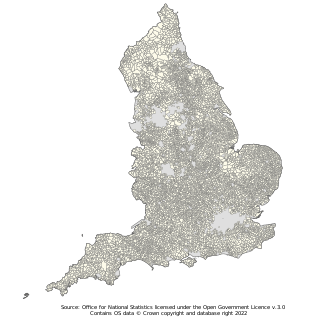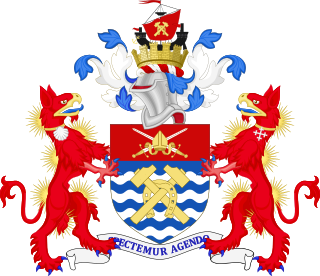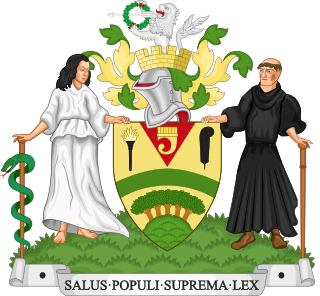
The administrative geography of the United Kingdom is complex, multi-layered and non-uniform. The United Kingdom, a sovereign state to the northwest of continental Europe, consists of England, Northern Ireland, Scotland and Wales. For local government in the United Kingdom, England, Northern Ireland, Scotland and Wales each have their own system of administrative and geographic demarcation. Consequently, there is "no common stratum of administrative unit encompassing the United Kingdom".

A parish council is a civil local authority found in England, which is the lowest tier of local government. They are elected corporate bodies, with variable tax raising powers, and they carry out beneficial public activities in geographical areas known as civil parishes. There are about 10,480 parish and town councils in England. Parish councils may be known by different styles, they may resolve to call themselves a town council, village council, community council, neighbourhood council, or if the parish has city status, it may call itself a city council. However their powers and duties are the same whatever name they carry.

Local government in England broadly consists of three layers: civil parishes, local authorities, and regional authorities. Every part of England is governed by at least one local authority, but parish councils and regional authorities do not exist everywhere. In addition, there are 31 police and crime commissioners, four police, fire and crime commissioners, and ten national park authorities with local government responsibilities. Local government is not standardised across the country, with the last comprehensive reform taking place in 1974.

Referendums in the United Kingdom are occasionally held at a national, regional or local level. Historically, national referendums are rare due to the long-standing principle of parliamentary sovereignty. There is no constitutional requirement to hold a national referendum for any purpose or on any issue however the UK Parliament is free to legislate through an Act of Parliament for a referendum to be held on any question at any time.

In England, a civil parish is a type of administrative parish used for local government. It is a territorial designation which is the lowest tier of local government. Civil parishes can trace their origin to the ancient system of parishes, which for centuries were the principal unit of secular and religious administration in most of England and Wales. Civil and religious parishes were formally split into two types in the 19th century and are now entirely separate. Civil parishes in their modern form came into being through the Local Government Act 1894, which established elected parish councils to take on the secular functions of the parish vestry.
A parish meeting is a meeting all the electors in a civil parish in England are entitled to attend.

The Local Government Act 1894 was an Act of the Parliament of the United Kingdom that reformed local government in England and Wales outside the County of London. The Act followed the reforms carried out at county level under the Local Government Act 1888. The 1894 legislation introduced elected councils at district and parish level.

The Local Government (Scotland) Act 1889 is an Act of the Parliament of the United Kingdom which was passed on 26 August 1889. The main effect of the act was to establish elected county councils in Scotland. In this it followed the pattern introduced in England and Wales by the Local Government Act 1888.

The London Government Act 1899 was an Act of the Parliament of the United Kingdom that reformed the administration of the capital. The Act divided the County of London into 28 metropolitan boroughs, replacing the 41 parish vestries and District Boards of Works administering the area. The legislation also transferred a few powers from the London County Council to the boroughs, and removed a number of boundary anomalies. The first elections to the new boroughs were held on 1 November 1900.

The Metropolis Management Act 1855 was an Act of the Parliament of the United Kingdom that created the Metropolitan Board of Works, a London-wide body to co-ordinate the construction of the city's infrastructure. The Act also created a second tier of local government consisting of parish vestries and district boards of works. The Metropolitan Board of Works was the forerunner of the London County Council.
Highway districts were areas in England and Wales united for the maintenance and repair of highways. They were first formed in 1862 and consisted of groupings of civil parishes in rural areas. They were abolished in 1894 when their powers and duties passed to rural district councils.

The Town and Country Planning Act 1947 was an Act of Parliament in the United Kingdom passed by the Labour government led by Clement Attlee. It came into effect on 1 July 1948, and along with the Town and Country Planning (Scotland) Act 1947 was the foundation of modern town and country planning in the United Kingdom.

The Local Government Act 1958 was an Act of the Parliament of the United Kingdom affecting local government in England and Wales outside London. Among its provisions it included the establishment of Local Government Commissions to review the areas and functions of local authorities, and introduced new procedures for carrying these into action.
The history of local government in England is one of gradual change and evolution since the Middle Ages. England has never possessed a formal written constitution, with the result that modern administration is based on precedent, and is derived from administrative powers granted to older systems, such as that of the shires.

Havering London Borough Council is the local authority for the London Borough of Havering in Greater London, England. It is a London borough council, one of 32 in the United Kingdom capital of London. Havering is divided into 18 wards, each electing three councillors. Since May 2018, Havering London Borough Council has been in no overall control. It comprises 22 Havering Residents Association members, 20 Conservative Party members, 9 Labour Party members, 3 East Havering Residents' Group members and 1 Upminster and Cranham Residents Association member. The council was created by the London Government Act 1963 and replaced two local authorities: Hornchurch Urban District Council and Romford Borough Council.
The Royal Commission on London Government, also known as the Ullswater Commission, was a Royal Commission which considered the case for amendments to the local government arrangements in the County of London and its environs. The commission was chaired by Viscount Ullswater, appointed in October 1921, and reported in 1923. The inquiry was described as an "unmitigated disaster" for proponents of reformed local government in the capital, as the commission failed to reach a unanimous decision. The majority report recommending virtually no change was signed by four commissioners, one of whom added a memorandum of dissent. Two minority reports, each signed by two commissioners, reached differing conclusions. In the event, administrative reforms were not carried out until 1965 following another inquiry.

Hammersmith and Fulham London Borough Council is the local authority for the London Borough of Hammersmith and Fulham in Greater London, England. It is a London borough council, one of 32 in the United Kingdom capital of London. Hammersmith and Fulham is divided into 21 wards, electing a total of 50 councillors. The council was created by the London Government Act 1963 as the Hammersmith London Borough Council and replaced two local authorities: Hammersmith Metropolitan Borough Council and Fulham Metropolitan Borough Council. The council was renamed on 1 January 1980.

Harrow London Borough Council is the local authority for the London Borough of Harrow in Greater London, England. It is a London borough council, one of 32 in the United Kingdom capital of London. It is currently controlled by the Conservative Party with 31 seats. The Labour Party is the sole opposition, with 24 seats.

Taxation in Wales typically comprises payments to one or more of the three different levels of government: the UK government, the Welsh Government, and local government.













